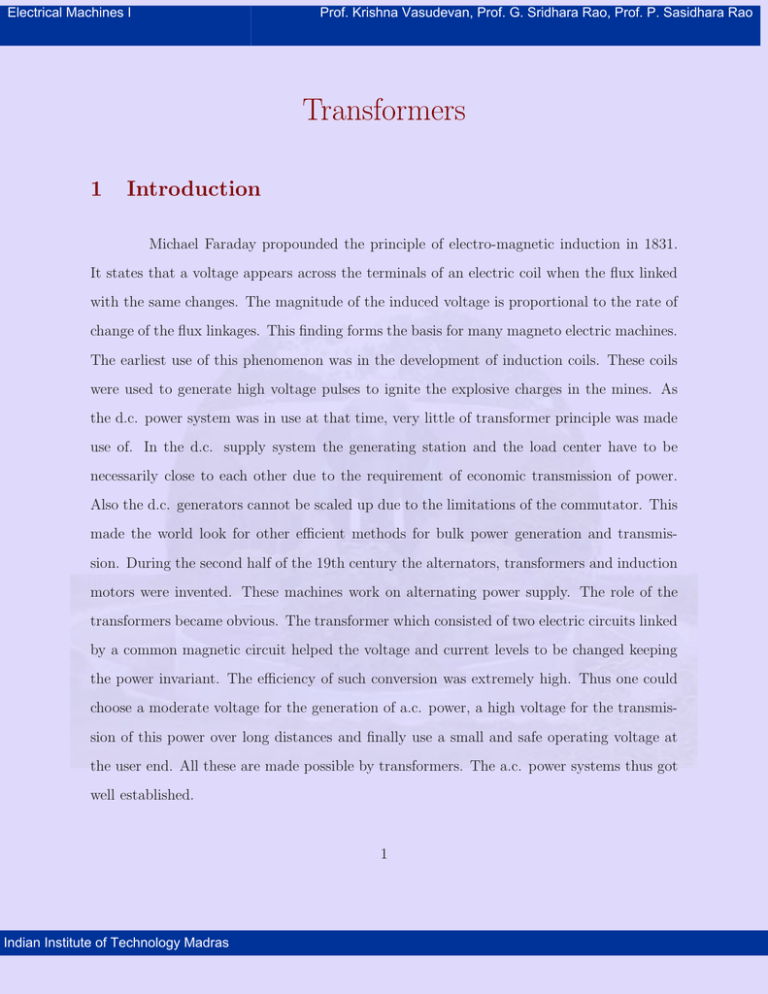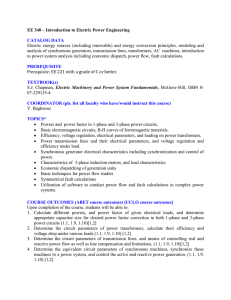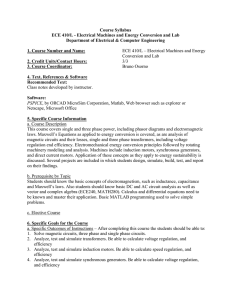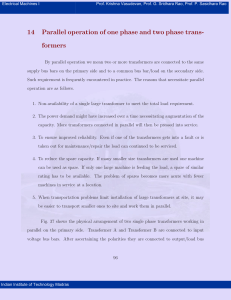Transformers
advertisement

Electrical Machines I Prof. Krishna Vasudevan, Prof. G. Sridhara Rao, Prof. P. Sasidhara Rao Transformers 1 Introduction Michael Faraday propounded the principle of electro-magnetic induction in 1831. It states that a voltage appears across the terminals of an electric coil when the flux linked with the same changes. The magnitude of the induced voltage is proportional to the rate of change of the flux linkages. This finding forms the basis for many magneto electric machines. The earliest use of this phenomenon was in the development of induction coils. These coils were used to generate high voltage pulses to ignite the explosive charges in the mines. As the d.c. power system was in use at that time, very little of transformer principle was made use of. In the d.c. supply system the generating station and the load center have to be necessarily close to each other due to the requirement of economic transmission of power. Also the d.c. generators cannot be scaled up due to the limitations of the commutator. This made the world look for other efficient methods for bulk power generation and transmission. During the second half of the 19th century the alternators, transformers and induction motors were invented. These machines work on alternating power supply. The role of the transformers became obvious. The transformer which consisted of two electric circuits linked by a common magnetic circuit helped the voltage and current levels to be changed keeping the power invariant. The efficiency of such conversion was extremely high. Thus one could choose a moderate voltage for the generation of a.c. power, a high voltage for the transmission of this power over long distances and finally use a small and safe operating voltage at the user end. All these are made possible by transformers. The a.c. power systems thus got well established. 1 Indian Institute of Technology Madras Electrical Machines I Prof. Krishna Vasudevan, Prof. G. Sridhara Rao, Prof. P. Sasidhara Rao Transformers can link two or more electric circuits. In its simple form two electric circuits can be linked by a magnetic circuit, one of the electric coils is used for the creation of a time varying magnetic filed. The second coil which is made to link this field has an induced voltage in the same. The magnitude of the induced emf is decided by the number of turns used in each coil. Thus the voltage level can be increased or decreased by changing the number of turns. This excitation winding is called a primary and the output winding is called a secondary. As a magnetic medium forms the link between the primary and the secondary windings there is no conductive connection between the two electric circuits. The transformer thus provides an electric isolation between the two circuits. The frequency on the two sides will be the same. As there is no change in the nature of the power, the resulting machine is called a ‘transformer’ and not a ‘converter’. The electric power at one voltage/current level is only ‘transformed’ into electric power, at the same frequency, to another voltage/current level. Even though most of the large-power transformers can be found in the power systems, the use of the transformers is not limited to the power systems. The use of the principle of transformers is universal. Transformers can be found operating in the frequency range starting from a few hertz going up to several mega hertz. Power ratings vary from a few milliwatts to several hundreds of megawatts. The use of the transformers is so wide spread that it is virtually impossible to think of a large power system without transformers. Demand on electric power generation doubles every decade in a developing country. For every MVA of generation the installed capacity of transformers grows by about 7MVA. These figures show the indispensable nature of power transformers. 2 Indian Institute of Technology Madras




